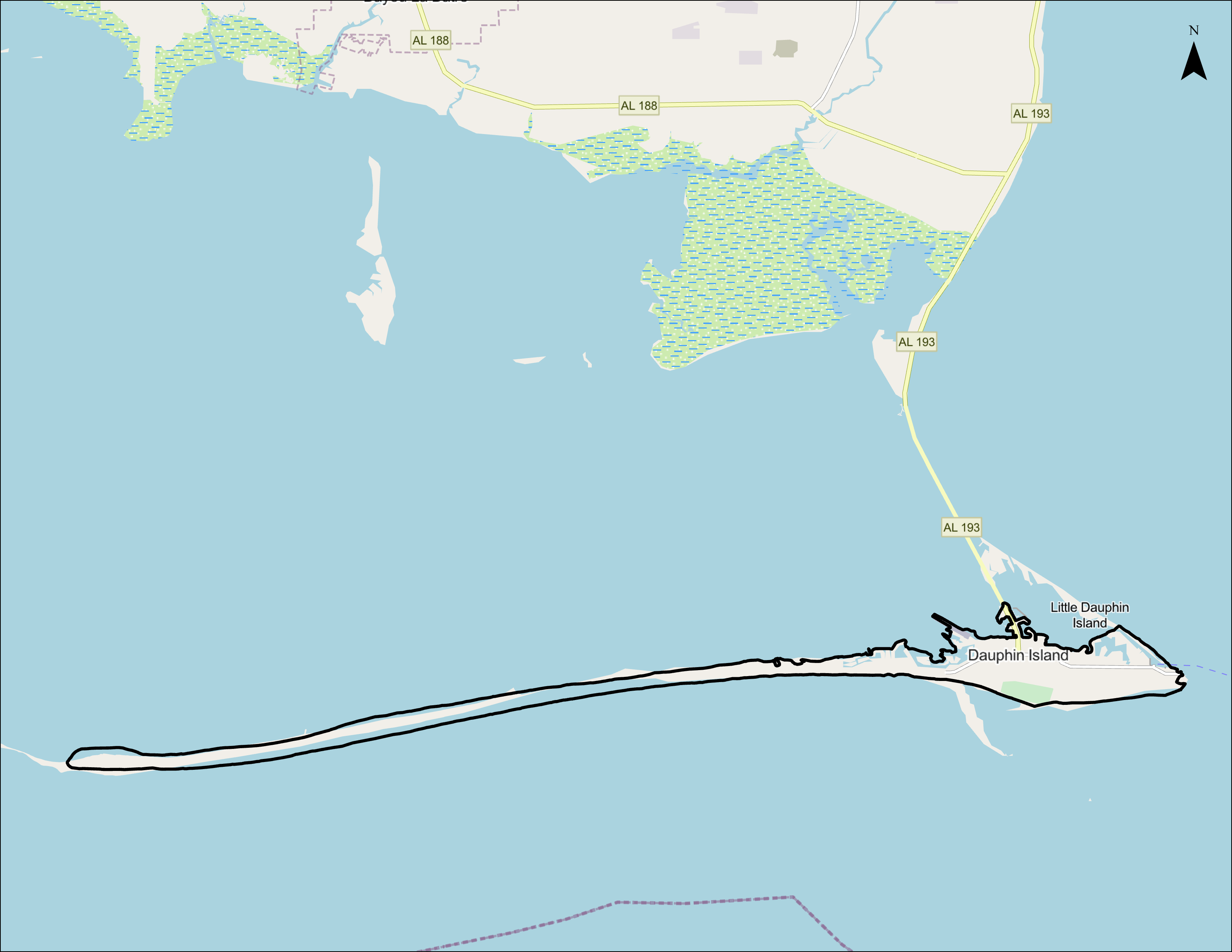The Landscape

Watershed Size and Location
Dauphin Island is a barrier island that sits right off the coast of Alabama is just 14 miles long and is 1.75 miles at its widest point. The watershed is fairly small, only covering about 3,852 acres of land. Dauphin Island has a fairly sized urban population, as most people are visitors to the island. Total land use breakdown: 34% urban, 39% other uses, 20% water, and 7% forested land.
Main Tributaries and Tidal Influence
Dauphin Island (HUC 031700090202) does not have any main tributaries, but multiple small water bodies dot the island: Spring Bayou, Woods Bayou, Dauphin Island Bay, Alligator Lake, Oleander Pond, Bayou Second, Bayou Aloe, and Graveline Bay all make up the Dauphin Island watershed. Since it is a barrier island, Dauphin Island is heavily influenced by the tides.
Water Use Classification and Impairments
ADEM classifies Dauphin Island water use as Swimming and Whole Body Contact, Fish & Wildlife, and Shellfish Harvesting. Dauphin Island and its surrounding waters were listed on Alabama's 2010 303(d) list of impairments due to the Deepwater Horizon Oil Spill.
Human Uses
Dauphin Island is known for its birdwatching, as many species of birds congregate on the island for nesting or as migrants. The island has a three-mile nature trail that lays within the Audubon Bird Sanctuary. The historical site Fort Gaines is located on the eastern tip of Dauphin Island and is five years shy of being 200 years old. Fishing is a popular sport on the island as well as boating, jet skiing, and kayaking. Dauphin Island currently possesses twenty-seven private boat ramps, two public boat launches, and one public fishing pier, with plans to construct a handicap accessible kayak launch.
Ecological Importance
Dauphin Island is known for its vast array of bird species. The Audubon Bird Sanctuary consists of 137 acres of maritime forest, marshes, and dunes, including a lake, a swamp, and a beach. Recently, the 3-mile trail system within the Sanctuary has been designated as a National Recreational Trail. It is located at the Eastern end of Dauphin Island. The Sanctuary is of vital importance because it is the largest segment of protected forest on the Island and the first landfall for neotropical migrant birds after their long flight across the Gulf from Central and South America each spring. Here these birds, often exhausted and weakened from severe weather during the long flight, find their first food and shelter. Of the 445 species officially documented in Alabama presently, 420 (95%) have been observed on the island. It is also their final stop before their return flight each fall. The Bird Sanctuary has allowed Dauphin Island to be recognized by the National Audubon Society as being “Globally Important” for bird migrations. The estuaries around Dauphin island act as a nursery for many commercially important species such as the Red drum (Sciaenops ocellatus), Red Snapper (Lutjanus campechanus), Blue crab (callinectes sapidus), White shrimp (litopenaeus setiferus), and the Eastern oyster (Crassostrea virginica). There are regulations in regards to these species in order to ensure that they continue to remain a sustainable resource. The USFWF documented these T&E species: Bald eagle (Haliaeetus leucocephalus), Wood stork (Mycteria americana), Piping Plover (Charadrius melodus), Red knot (Calidris canutus rufa), Alabama heel-splitter (Potamilus inflatus), Southern club shell (Pleurobema decisum), Alabama sturgeon (Scaphirhynchus suttkusi), Atlantic sturgeon (Acipenser oxyrinchus desotoi), West Indian Manatee (Trichechus manatus), Hawksbill sea turtle (Eretmochelys imbricata), Leatherback sea turtle (Dermochelys coriacea), Kemp's Ridley sea turtle (Lepidochelys kempii), Loggerhead sea turtle (Caretta caretta), Alabama red-bellied turtle (Pseudemys alabamensis), Eastern indigo snake (Drymarchon corais couperi), Black pine snake (Pituophis melanoleucus lodingi), and the Gopher tortoise (Gopherus polyphemus).




